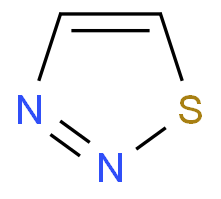1. Names and Identifiers
- 1.1 Name
- Thiadiazole
- 1.2 Synonyms
- Diazosulfide; THIADIAZOLE;
- 1.3 CAS No.
- 288-48-2
- 1.4 CID
- 67518
- 1.5 Molecular Formula
- C2H2N2S
- 1.6 Inchi
- InChI=1S/C2H2N2S/c1-2-5-4-3-1/h1-2H
- 1.7 InChkey
- UGUHFDPGDQDVGX-UHFFFAOYSA-N
- 1.8 Canonical Smiles
- C1=CSN=N1
- 1.9 Isomers Smiles
- C1=CSN=N1
2. MSDS
2.Hazard identification
2.1 Classification of the substance or mixture
no data available
2.2 GHS label elements, including precautionary statements
| Pictogram(s) | no data available |
| Signal word | no data available |
| Hazard statement(s) | no data available |
| Precautionary statement(s) | |
| Prevention | no data available |
| Response | no data available |
| Storage | no data available |
| Disposal | no data available |
2.3 Other hazards which do not result in classification
no data available
3. Computed Properties
- Molecular Weight:86.11568g/mol
- Molecular Formula:C2H2N2S
- Compound Is Canonicalized:True
- Exact Mass:0.4
- XLogP3-AA:85.99386925
- Monoisotopic Mass:85.99386925
- Complexity:30.8
- Rotatable Bond Count:0
- Hydrogen Bond Donor Count:0
- Hydrogen Bond Acceptor Count:3
- Topological Polar Surface Area:54
- Heavy Atom Count::5
- Defined Atom Stereocenter Count:0
- Undefined Atom Stereocenter Count:0
- Defined Bond Stereocenter Count:0
- Undefined Bond Stereocenter Count:0
- Isotope Atom Count:0
- Covalently-Bonded Unit Count:1
- CACTVS Substructure Key Fingerprint:AAADcQBDAABAAAAAAAAAAAAAAAAAAWAAAAAAAAAAAAAAAAABgAAAHAQIQAAAAADFQgSsgRAAAACmABAnQAAAJBAAggBYAAwQIAAAAAAAAAAAAAAAAAAAAAAAAAAAAAAAAAAAAAAAAAAAAAAAAAAAAAAAAA==
4.Other Information
- Description
- 1,2,3-Thiadiazole is a five-membered, π-excessive, stable, almost planar, unsaturated, conjugated, heteroaromatic comprised of one sulfur atom, two adjacent nitrogen atoms (S–N–N), and two carbon atoms. There are four possible noninterconvertible regioisomeric structures depending on the relative position of heteroatoms.
- Physical properties
- The parent 1,2,3-thiadiazole is a yellow-colored liquid with a bp of 157°C. It is a weak base, thermally stable, and soluble in water and most of the organic solvents such as alcohol, ether, DCM, and chloroform.
- Uses
- 1,2,3-Thiadiazoles have broader applications as insecticide synergists, cross-linked polymer compounds, and herbicides. Besides agro-applications there are other applications such as sedative, antibacterial and antibiotic, antiviral, and neurodegenerative.
- Chemical Reactivity
- As is evident from the electron density map on the ring atoms, both C4 and C5 carbon atoms have the least electron density compared to nitrogen, making them resistant to electrophilic attack on carbon atoms but facile to nitrogen atoms. However, nucleophilic substitution is facile to carbon atoms.
5. Related Questions
6. Realated Product Infomation

 EN
EN
